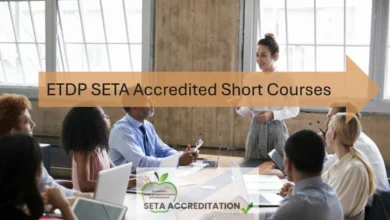
You know that feeling when you’ve studied hard for an exam, but the rules for passing keep changing? You tick all the boxes, but still, there’s a “Sorry, you’re not quite there yet” message flashing on the screen. That’s kinda what chasing SETA Accreditation Requirements feels like for many training providers and businesses in South Africa. The process is full of official forms, rules, and some stuff that makes you wanna pull your hair out. But hey—what if there’s a better way to smash through those hurdles and start training with confidence?
Why Getting SETA Accreditation Feels So Tricky
Let’s be real: SETA Accreditation Requirements can look like a maze. You want your training to count, your learners to get certified, and your business to grow. But just when you think you’ve got it, another document pops up, or a new standard appears. It’s like trying to build a sandcastle while the tide keeps coming in.
That’s why understanding the basics, the not-so-obvious rules, and the SETA Accreditation Requirements is the real game changer. Once you know what’s really expected, you can stop guessing and start making real progress. Ready to find out how?
What Are SETA Accreditation Requirements (And Why Do They Matter)?
If you want to run a legit training program in South Africa, you’ll need SETA Accreditation. SETA stands for Sector Education and Training Authority. There are different SETAs for different industries—like construction, IT, or hospitality. These bodies check that your training is up to scratch and matches the national standards.
SETA Accreditation Requirements are like the rules of a big football match. If you don’t play by them, you’re not getting on the field. Meeting these requirements means your courses are trusted, your learners can get official certificates, and you’re seen as a pro in your field. Miss the mark, and you’re left on the sidelines.
Curious about the official details? The South African Qualifications Authority (SAQA) keeps the national standards and qualifications framework, while each SETA has its own checklist. The Department of Higher Education and Training also lays down the law for training providers.
Learning from Others: How One Training Provider Nailed It
Picture this: Sipho runs a small IT training business in Johannesburg. He’s got great courses, but companies keep asking, “Are you SETA-accredited?” At first, Sipho thought it was just paperwork. But after his first attempt, he got a rejection email—missing key staff qualifications and outdated learning materials.
Instead of giving up, Sipho reached out to a SETA consultant, joined an online community, and started following every step. He found out he needed to update his course content, train his facilitators, and keep proof of everything. After a few months, and a bit of hustle, Sipho’s business got that golden SETA stamp. Now, his classes are more popular, and he gets contracts from big companies—because he’s playing by the right rules.
Breaking Down SETA Accreditation Requirements
The official list of SETA Accreditation Requirements can feel overwhelming. But think of it like baking a cake: you need the right ingredients, the right tools, and you have to follow the recipe. Miss a step, and your cake flops.
Here are the key things SETA checks:
- That your training matches national standards
- You have qualified trainers and assessors
- Your learning materials are up-to-date and relevant
- You’ve got proper policies (like appeals, assessments, and moderation)
- You keep records and proof of what you teach
- Your facilities and resources are up to scratch
- Your business is registered and legit
Sounds like a lot? Don’t worry. Let’s look at how you can tackle each part, one by one.
7 Must-Try Ways to Meet SETA Accreditation Requirements (and Stand Out)
1. Align Your Courses with National Standards
Think of SETA Accreditation Requirements like the rules of a board game. If you don’t follow them, you can’t win. Make sure your course content matches the National Qualifications Framework (NQF). Check out the NQF website and see how your training fits in. This is your “ingredients list”—don’t skip a step, or your cake won’t rise.
2. Invest in Qualified Trainers and Assessors
Imagine sending a soccer team onto the field with no coach. It’s gonna be chaos, right? SETA wants proof that your trainers and assessors are qualified for the job. Make sure they’ve got the right certificates and keep them updated. If your staff needs upskilling, consider short courses or workshops. This step builds your team’s credibility and helps you pass those tough audits.
3. Keep Learning Materials Current
Old textbooks and outdated slides just won’t cut it. SETA checks if your learning materials match current industry trends. Look at what’s happening in your sector. Are there new laws, new tools, or new ways of working? Update your training packs and add fresh case studies. It’s like swapping out a cracked phone for the latest model—your learners and SETA will notice the difference.
4. Put Policies in Place (and Use Them!)
Policies aren’t just for show—they’re the “user manual” for your training business. SETA Accreditation Requirements want to see things like fair assessment rules, moderation processes, and how you handle appeals. Write these down, share them with your team, and use them every day. It’s kinda like having traffic lights on a busy road—everyone knows when to stop, go, or slow down.
5. Stay Organized with Record-Keeping
You wouldn’t try to find a song without a playlist, right? Keep clear records of attendance, assessments, moderation, and feedback. SETA auditors love seeing neat files (digital or paper). This makes it way easier to answer questions or prove you’re following the rules. Plus, it means you’re always ready if someone wants to check your work.
6. Check Your Facilities and Resources
SETA doesn’t expect a fancy building, but your training space must be safe and suitable. Make sure your classrooms (physical or online) are equipped for the courses you offer. This means enough computers, safe seating, good lighting, and all the learning tools your students need. Think of it like prepping your kitchen before cooking—if you forget the oven, your cake won’t bake!
7. Register Your Business and Stay Compliant
Before you even start, your business must be registered with the right authorities. This includes CIPC registration, tax clearance, and bank accounts in your business name. SETA checks all this because they want to know you’re legit. Keep your paperwork up-to-date, and always have copies ready to show. It’s like carrying your ID—you never know when you’ll need it.
What Happens If You Don’t Meet SETA Accreditation Requirements?
Not meeting SETA Accreditation Requirements can cost you. You might lose contracts, your learners can’t get recognized certificates, and your reputation takes a hit. It’s like failing to register for a marathon—you might be the best runner, but you’re not getting that medal.
The good news is, with the right approach, you can avoid these pitfalls. There are loads of resources out there, like the ETDP SETA website, where you can find more info, templates, and guidelines.
Level Up: Why Meeting SETA Accreditation Requirements Is Worth the Hustle
Sure, it’s a lot of work. But once your business is SETA-accredited, you’re opening doors. More clients, more credibility, and the chance to make a real impact in your community. Think of it as unlocking a cheat code in a game—suddenly, everything gets easier.
If you’re ready to take your training to the next level, don’t let the maze of SETA Accreditation Requirements stop you. Start by checking your courses, upskilling your team, and getting your paperwork in order. Build those habits, and soon you’ll be the go-to provider everyone’s talking about.
Ready to stand out? Take the first step today and show South Africa what you can really do. Your journey to SETA success starts now!





